This page contains affiliate links. Please read our disclosure for more info.
Our Silver Stag bounded down Highway 68, the sun glistening off the reflective hood. Salmon rocks surrounded us in great shoals, rising up high to the edge of the road before falling back into great wide expanses while all the time backed by a vast ocean of blue.
Every few minutes we were compelled to stop by the scenery that beckoned us with it’s jagged beauty and try to capture some of this natural wonder with our woefully pathetic equipment*. Giant cacti dotted the landscape, looking like two men, one standing on the other’s shoulders, holding their arms held up to the sky.
If those men were also dressed in green outfits and had spikes coming out of them.
And no heads.
‘This,’ we thought. ‘Is going to make for some truly hyperbolic writing.’
Day 1: Salta – Cafayate
- 190km
- 3.5 hours
- Tarmac
We left Salta and took Ruta 68 south towards the Valles Calchaquíes. The drive starts innocuously enough but after an hour or so we left the cowardly clouds and green countryside behind and bravely entered the imposing rock formations of the Quebrada de Cafayate.
These giant red mountains and two-men-dressed-in-green-sized cacti feel like some crazily enlarged version of the Wild West and each turn of the corner brings in amazing new views. We took time to enter the Garganta del Diablo (Devil’s Throat – this is the devil when he has a dry throat – there are others) and tickle his tonsils before the extreme angles of some of the slabs forced us to turn back rather unheroically.
No devil conquering here.
After the heady rush of being swallowed by a demon, Cafayate is a blissful, laid-back haven. It’s a small, touristy town but as we were here in the depths of winter it wasn’t too busy.
The central plaza is overlooked by mountains and surrounded by vineyards and there are plenty of bodegas to get bottles of the best booze this side of Buenos Aires (pick up a map from the tourist information hut on the main square). Many of these rather swanky Wine Factories offer tours and tastings and are easily reached on foot or by bike (but not by car, OK?).
We paid A$5 (taken off any purchase) for a tour of the Nanni bodega, right in the centre of town, where we sniffed and swished and tried to pretend we knew what we were talking about. Although our sommelier skills are sadly lacking, we were able to tell that we were tasting some fine wines (i.e. they didn’t have the throaty, vinegar twang) and walked away with a decent bottle of Rose.
We also tried the free but less extensive tasting at El Transito across the road but we didn’t like those wines as much as they didn’t let us try as many we found them a little harsher than the silky smoothness of Nanni’s selection.
Whether it was the warm, sunny weather, mountain views or wine (possibly the wine) we loved Cafayate and stayed three nights in the area.
Where To Eat
Thanks to a recommendation from Audrey at Uncornered Market we ate lunch everyday at La Casa de Las Empanadas (Mitre 24, just off the main plaza). Usually these pastries come in three flavours: beef, chicken and cheese so we were pleased to find a huge range of options including plenty of vegetarian flavours.
Our favourites were the Vegetariano (squash, aubergine, goats cheese and the local torrontes white wine) and La Griega (olives, goats cheese and tomato). At 2 pesos each you can fill yourself up for US$1.50. It’s a simple place with rickety wooden tables and walls covered in graffiti from happy previous customers.
You can also sample wine flavoured ice cream at Heladería Miranda (Guemes Norte 170). It’s more like sorbet, and is rather strong but if you like wine it’s worth a try.
Where To Stay
We treated ourselves as we had heard about a great deal at Altalaluna, a boutique hotel just outside Tolombon 14 km from Cafayate. It’s a beautiful Spanish style building set on a vineyard with wonderful views of the surrounding mountains. There’s a pool, spa, comfy lounge area with open fire (and wifi) and large gardens. Our comfortable, spacious room had its own balcony overlooking the vineyard with gorgeous sunset views. Best of all, it was utterly tranquil. At 468 pesos ($120) for two nights including breakfast and three course dinner it was totally worth it.
Day 3: Cafayate – Quilmes – Cafayate
- 55km (each way along Ruta 40)
- 1 hour (each way)
- Tarmac (gravel for the 10 minute drive to the ruins)
On our last day in Cafayate we took a half day trip to Quilmes. These indigenous, pre-Incan ruins set into a hill feel like they are in the middle of nowhere and only a few tourists make it out here.
Like many archaeological sites, a series of low stone walls is all that is left of the citadel but the setting amongst the cacti is atmospheric and the views from the top of the hill are spectacular – you can see for miles into the vast desert landscape.
Entry to the ruins was 10 pesos each. There is a hotel right by the hill but it was as abandoned as the ruins, so we ate our meals and stayed the night in Cafayate.
Day 4: Cafayate – Cachi
- 165km
- 5 hours
- Gravel for most of the way
The road to Cachi is paved with…well, not much really. It mostly consists of gravel, but that’s not telling you anything because, after driving on it for two hours, you begin to notice that there is actually a wide variety of different gravels.
There’s the rocky gravel with the larger stones that make worrying thunks as they bounce off your bodywork.
There is the sandy gravel, smooth but slightly slippy. The temptation to grab the handbrake as you go around corners on this surface is huge but is not (entirely) recommended.
Then there is the bitty, rutted gravel. We’re not sure if the ruts are caused by trucks or by the weather, but you’ll quickly find out if you have any loose fillings.
Unfortunately, it seems that this is the gravel that is most common along this road.
Despite the conditions (or perhaps because of – my teeth are falling out, this must be an ADVENTURE!), the drive is actually really enjoyable as it feels very isolated – we didn’t see any other cars for hours – and the scenery is spectacular.
Driving through the Quebrada de Las Flechas you pass small hamlets made tiny by the huge gorges and ginormous jagged red rocks that surround them where men on horses herd tribes of goats past simple one-roomed churches.
Of course, with cinematic scenery like this, you’ll need cinematic snacks. But be warned, there aren’t many places to stop along the way so, if you have an appetite like Simon, bring plenty with you. Also, lots of water might be an idea too.
We did take a break at Molinos, a sleepy village with a pretty whitewashed church, to buy more hard candy (Simon was getting grouchy).
Cachi felt more desolate than Cafayate. The exotic red mountains changed to a more muted brown, the temperature dropped and the trees had a wintry bareness. The small town is pretty though, with low colonial-style buildings encased by mountains – some reaching as high as 6000m.
We attempted a walk to Cachi Adentro but ended up on the World’s Bleakest Runway™. There was no control tower or hangers or, you know, flying machines, just this mile-long stretch of wide tarmac marked with a giant 02 and set into an wind-swept plain. A lone windsock helpfully told us which way the icy gale was heading (naturally, it was right into our uncovered faces).
We considered, briefly, hiking to the nearest mountain to Make The Most Of It like the English we are, but distances are deceptive on terrain so flat and after 10 minutes we had barely cleared the airplane turning circle and the hill was still a long way away.
We gave up. We’re not that English.
On our return, we had a chat to the hotel receptionist and he recommended what he described as a ‘muy bonita‘ drive. The plan was to head towards Al Algarrobal and loop around back via Cachi Adentro and we were promised beautiful scenery along the road with the added bonus of protection from the typhoon-strength winds.
We found the beautiful scenery easily enough, it was just the road we had trouble with.
After we had driven through our second river(!) and the sandy goat track, that was never really that wide to begin with, got even narrower, we finally figured we’d gone the wrong way.
To the left of this road of sand was one of the aforementioned rivers, dotted with huge, car-breaking rocks. On the right was a large, car-rolling hill.
‘Best turn around.’ Erin said calmly from the comfort of her passenger seat.
Through a magical feat of maneuvering and at least two decidedly unnerving moments involving boulders and spinning tires, we managed to get the Silver Stag turned around and we drove back through the two rivers, rental car unscathed, to the relative safety and solidity of the gravel track.
Where To Stay
We continued our extravagance by staying at Hostaria ACA and bargaining a 277 peso room down to 193. Our room was comfortable and bright and the garden had lovely views. They had wifi in the lounge (and in our room if you sat by the bathroom, had the front door open and the wind was blowing in the right direction).
Part 2 of Road Trippin’ – Northwest Argentina continues with our journey as we leave the Valles Calchaquíes and head up to the Quebrada de Humahuaca.
*We mean human-built image capturing equipment in general – we’re not travelling the world with a disposable Kodak or anything.
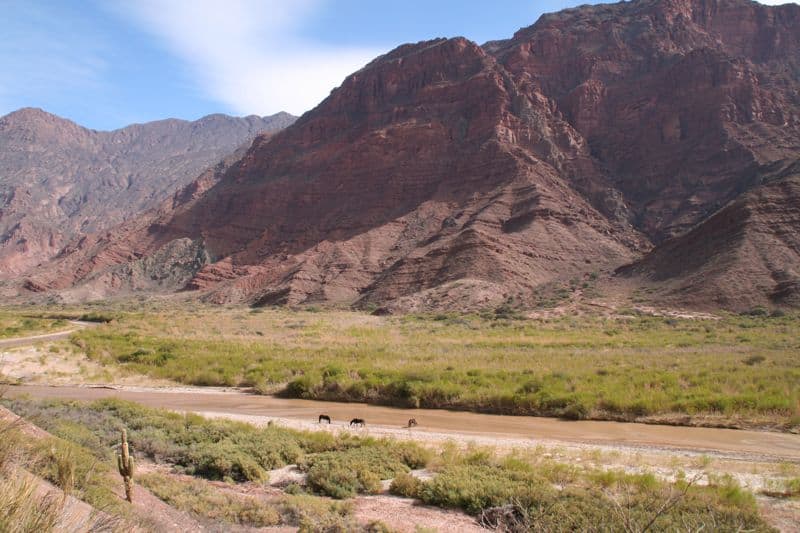
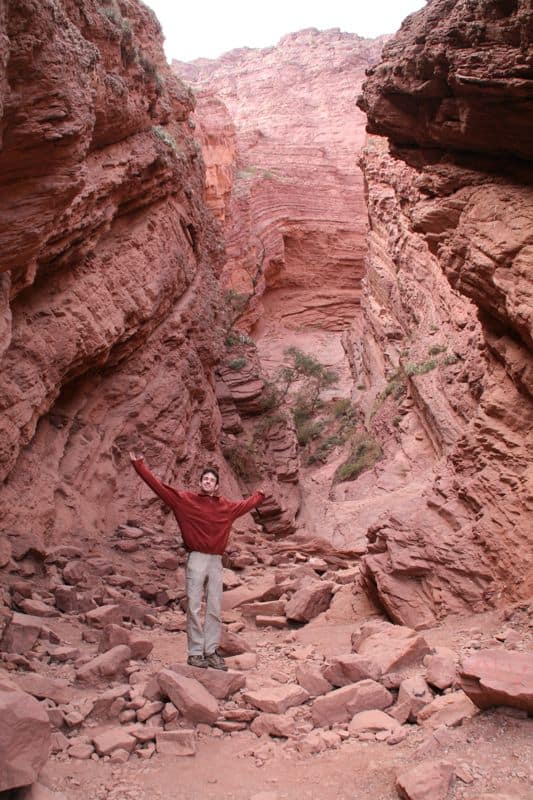
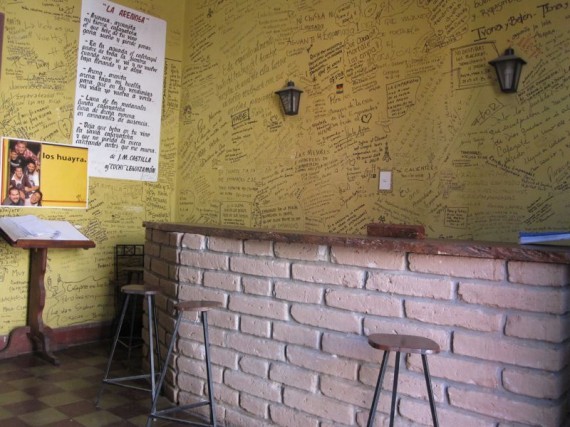
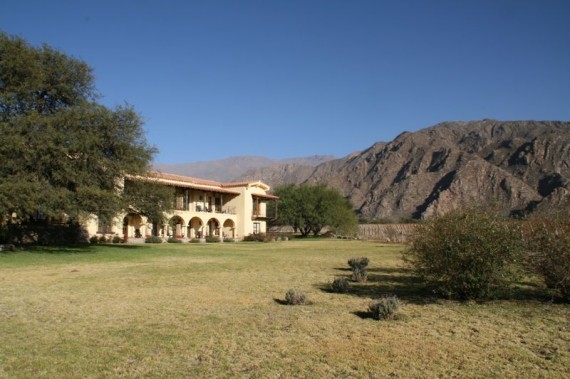
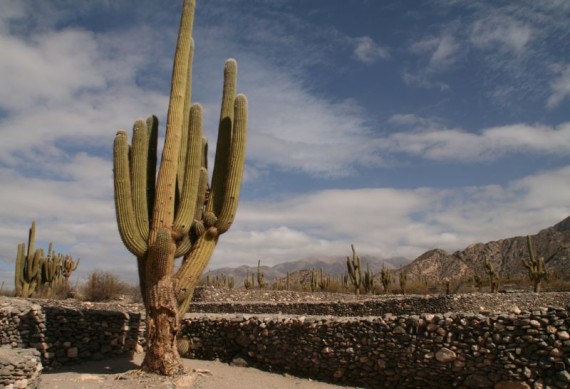
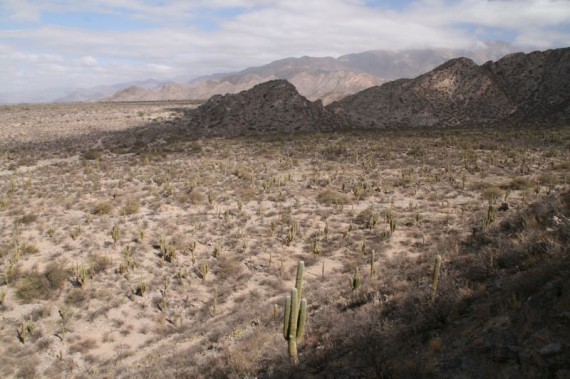
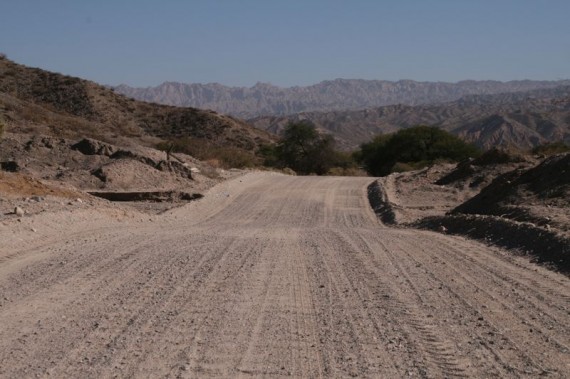
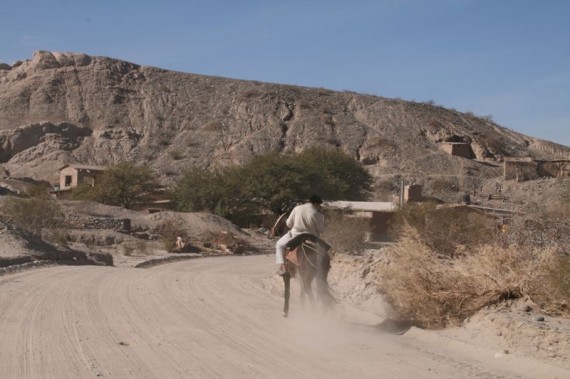
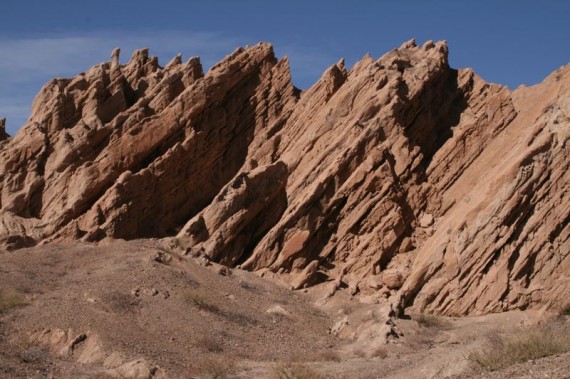
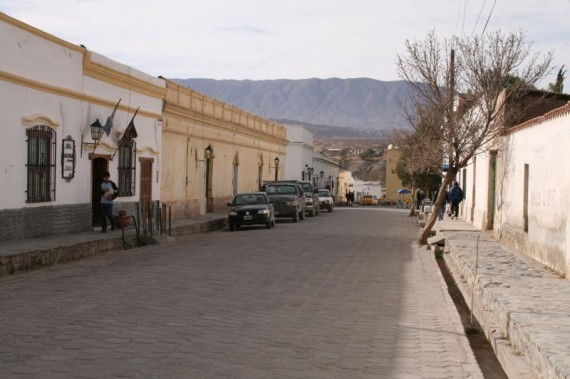
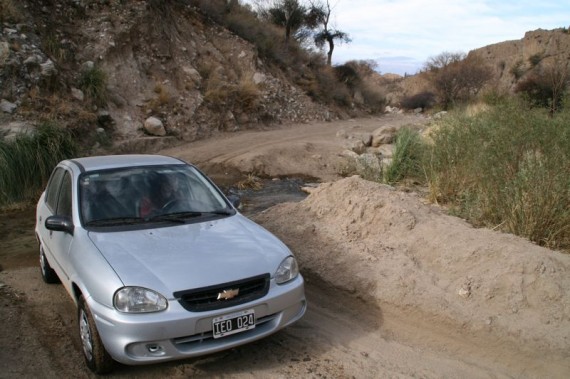
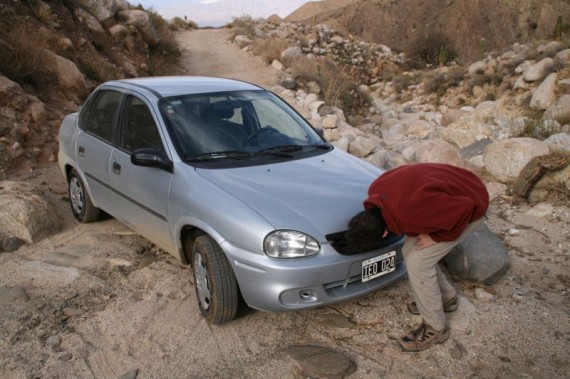
I’d kept this post marked for a while (almost 3 years, it seems looking at the date it was posted!) on my the google map I keep of recommended places…and we finally made use of it this past week! Zab and I were in Cafayate, did a tour of the Quebrada de las Conchas and ate at the Casa de Empanadas! FYI, the empanadas now cost AR$4.50 instead of AR$2!
Yay! Glad you made it there. The inflation in Argentina is crazy.
I came across your post looking for info about road trips around Salta. I’ll be doing that in a few weeks! Hopefully no issues… I’ll be driving stick for the first time in some 15 years. :)
Good luck and have fun!
Hi,
I’m planning a trip with my family to NW Argentina in March 2012. Your blog is very helpful. I just have a few questions: Is it necessary to hire a 4×4? We will probably be based in Salta and take day trips from there, i.e. driving ourselves as I prefer to avoid changing hotels very night. Is it likely we will be affected by altitude sickness? We have spent a week’s skiing in the Alps for the past 25 years but I imagine this cannot compare. We don’t intend to do any major trekking though.
Nicholena
We managed fine without a 4×4. We didn’t have a problem with altitude sickness. Just take it easy for the first few days and you should be fine. Have a great trip!
Hi Guys
We are planning to do a road trip from Mendoza to Salta. Is it feasible? Any tips?
Thanks
Pooja
We didn’t go to Mendoza so I don’t have any tips, but I can’t see why it’s not possible. Should be a great trip.
Just came across you site while looking up northwest argentina, maybe we will follow your route. The site detailing is stunning. Cheers.
We loved the road trip and highly recommend it. Enjoy!
Thanks Tom. We’d definitely recommend Argentina.
This was a really enjoyable read guys and the photography is awesome. You have really whet my appetite for Argentina and Argentine food and wine!
This is such a dream of mine! I can’t believe that I’ve been to Argentina 7X and have never taken a roadtrip. I looooved this post. Your pictures were fantastic!
You should so do it next time you are in Argentina!
I love your blog and your road trip looks like a lot of fun. It reminds me of some of the road trips my husband and I have done in northern Nevada. When you come to the U.S. you will have to explore Northern Nevada :-)
It did look a lot like the American West – we’d love to do a road trip when we get to the US.
Hey! I just discovered your blog recently, and I love it! I’m currently planning my first RTW trip, and I find it so inspiring what you guys have done! :)
Argentina looks AWESOME! Definitely somewhere I’m going to put on my list of places I want to visit! :)
Thanks Lauren. Argentina is a great country to visit. It’s easy to travel around (it’s more European than the rest of South America) and the scenery in the north west is amazing. Buenos Aires is a fun city and of course Iguazú Falls are spectacular. Let us know if you have any questions and good luck with the planning!
Hi there,
I am planning to visit Argentina in November this year.
My plan is to fly to Buenos Aires and to then go to:
Mendoza
San Martin de los Andes
Bariloche
Will 3 weeks be enough?
I can’t take more time unfortunately.
What can you suggest?
Thanks for your great website.
Cheers!!
Hi Andrea,
We have only visited Buenos Aires out of those places, but 3 weeks sounds like enough, if you are OK with long overnight bus trips or flying. Have a great trip!
That looks like an awesome place for a road trip, I want to go now!
It’s probably one of the best road trips we have ever done. We recommend it!
Hi. it’s was very helpful for me.We would like to travel Argentína for a month. And spend six days in Northwest. I know it is not enough to see all of thid area. I don’t know we travell by bus, rent a car or hire a guid or pay for a tour. What about??
A car will give you most flexibility and you can see more in less time. I don’t think you need a tour or guide.
Great write up. We did a week up there in May and enjoyed it.
We made the terrible (and very expensive) mistake of hiring a private guide for the first couple of days, but had a much, much better time after we got rid of her and rented a car on our own. Did you make it to the goat cheese farm in Cafayate?
Curious to hear your overall perspective on the North West and where you’d rank it among possible destinations in Argentina… We liked it, but we had heard so much hype about it before we went that we ended up a little disappointed. I’ll stay tuned for future installments :)
Best,
Ryan
We didn´t make it to the goats cheese farm in Cafayate although we did stay on a farm near Coronel Moldes that made great goats cheese.
The North West has been our favourite part of Argentina – we love it up here. That said, we have only visited Buenos Aires (for 2 months), a few places near BA and Iguazu Falls, so we don´t have much to compare it to. We definitely weren’t disappointed though.
I’m so glad you enjoyed La Casa de las Empanadas – I think we ate there every night in Cafayate as well! I found the wine tasting at El Transito really disappointing. We had bought a bottle of the cheaper Malbec the night before and really enjoyed it so we wanted to taste more at the tasting. But they were so cheap on the pours and when we asked to taste the reserve they refused. We ended up buying a bottle of the reserve Malbec and actually preferred the cheaper one in the end.
We went the opposite way on the loop – Salta to Cachi to Cafayate to Quilmes to Cafayate to San Antonio de los Cobres – and found each section to be different than the last and offer something new. This really is a great area for road trips…although we also had our share of scares with the car and going over rocks and streams.
Thanks Audrey – we did appreciate the empanada tip! We don’t know much about wine but the tasting at El Transito wasn’t amazing.
Good read, especially for someone planning to visit the region. I really the love the graphic embellishments you’ve added. Beautiful site.
Vindicated! Thanks very much Keith – Erin thought I was spending too much time doing them but your words have made it all worthwhile!
Great article, looks like you guys had a great time! The scenery is incredible, no? It’s great to hear about someone else gutsy enough to rent a car in Northern Argentina!
Hi Gareth, thanks for the comment. It is a wonderful place. I liked your write up of the area too.